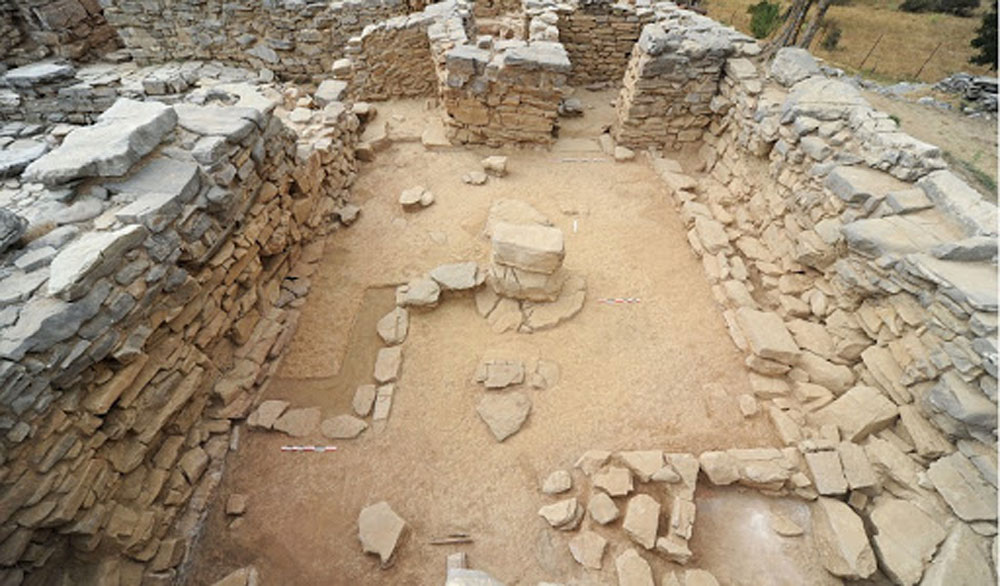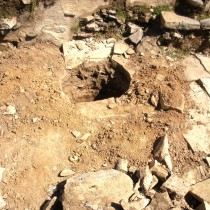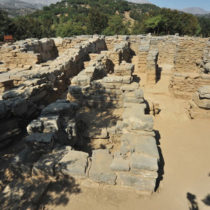A few days ago, the regional governor of Crete, Stavros Arnaoutakis, had a meeting with Honorary Head of Antiquities, Dr. Efi Sapouna-Sakellaraki, who is conducting excavations at Zominthos, Psiloritis.
Ms. Sapouna-Sakellaraki briefed Mr. Arnaoutakis about the successful course of this year’s systematic excavations lasting two months and the large number of finds unearthed during the archaeological dig at the highest known Minoan palace at Zominthos; a building which comprises 160 rooms both ground level and two-story.
According to Ms. Sapouna, excavations at Zominthos began in the late 1980s with her late husband, Archaeology professor Yiannis Sakellarakis, and continued at an intense pace in 2000 when the important Minoan palace was unearthed. Two months every summer, since the death of Yiannis Sakellarakis in 2010, his wife continues systematic excavations at the palace site where a wealth of archaeological finds have come to light.
As she stated, besides the discovery of the Zominthos palace, she has shared other great successful excavation projects in Crete with her late husband Yiannis Sakellarakis, who has been awarded for his valuable excavation work on the island by the University of Crete, the President of the Hellenic Republic, the Academy of Athens and others bodies.
Speaking to the Athens and Macedonia News Agency, Ms. Sapouna-Sakellaraki pointed out that there is admirable cooperation with the local government and referring to the Municipality of Anogia said that “… the excavation work has been greatly helped, mainly with moral support both from the present mayor Socratis Kefaloyiannis and all the ones before him, but also practically as for example during this period with the car lent to us by the Municipality. But also fundamentally, since there has always been a true bond with the Municipality of Anogia for years, as there had been a similar relationship with the present regional governor of Crete, Stavros Arnaoutakis, when he was mayor of Archanes”.
She also said that the aftermath of Ancient Zominthos’ excavation is important, as is the archaeological footprint in the greater area of Psiloritis and Crete. “Psiloritis is Crete, it is the symbol of Crete, therefore Zominthos is also the symbol of Crete. Ancient Zominthos is the only palace found in a mountainous area and is situated there because it is also the site of the Ideon Andron /Cave the most important sanctuary on Crete. Zominthos was very close to the Ideon Andron and the only accessible spot even during the winter months because in those times there was snow until August in the area of Psiloritis. To begin with, Zominthos was a religious center and then it became a political and economic center since it managed all the material wealth of Psiloritis, such as sheep’s wool, textiles, and fabrics which were all sent to the East. This is mentioned even in Egyptian sources which also speak about the medicinal and aromatic plants from Knossos. However, as Knossos was a transit center, all its supplies came from Psiloritis. I am now convinced that ancient Zominthos was a very important center and my personal opinion is that living in the Palace were both a priest from Knossos in charge of the Ideon Andron and a member of the dynasty who also had priestly duties since frescoes have been found and many sacred objects, bronze and gold seal stones proving that Zominthos was Crete’s timeless center of culture and economy”, said Ms. Sapouna-Sakellaraki to the Athens and Macedonia News Agency.





